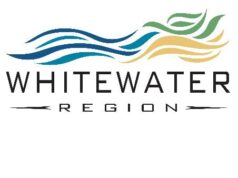Dear Editor,
Last week, the Canadian Nuclear Safety Commission (CNSC) blew into town to hold a Hearing to safeguard the continuing presence of the nuclear industry in Pembroke. With 7 members and a staff of about 30, including 2 security officers searching all public attendees, we taxpayers put on quite a show. I sat in for 7.5 hours, after being duly searched, to learn why there is concern about allowing more radioactive tritium to be released in Pembroke by SRB Technologies on Boundary Road.
While there were enough “scientific experts” speaking “nuke speak” to answer all questions raised by the 9 oral presenters, somehow they could not answer some questions and, in well practiced mode, they avoided these key questions:
1. Why is a Class 1 Nuclear facility working with and leaking carcinogenic nuclear waste operating in an industrial mall upwind of a small city and within 250 meters of a residence? Wouldn’t it be better placed in a facility better set up for dealing with such radioactive waste, like Chalk River or Darlington?
2. Why is the CNSC not concerned that higher than expected levels of Tritium (in its various forms, gas, liquid and solid) are being found in wells, in vegetables, gardens, and, most notably, in the city’s Sewage Sludge (400 Bq/Litre instead of the expected <100 Bcq/L)? Especially since recent CNSC research shows that Tritium persists in the environment much more stubbornly than previously understood or assumed? 3. Why is the CNSC not looking deeper into the statement that doctors in Ottawa are amazed at how many cases of colorectal cancer arrive there from Pembroke, way above the provincial average? 4. Since Tritium is used to make A-bombs and H-bombs more powerful, why is the CNSC staff suggesting that SRBT's license renewal not have reference to Canada's commitment to the International Nuclear Non-proliferation Treaty's provision for limiting Tritium's availability? 5. Why does the CNSC not track all shipments of radioactive Tritium and their safe disposal, rather than allowing end users of SRBT''s glow in the dark EXIT signs to have "free release" into Canadian landfills? (The Commission did say they will look into that) 6. As there seems to be international concern about Iran's nuclear program, why is SRBT allowed to sell its tritium products to Iran? 7 With marketplace trends leaning towards natural and safe, why is Pembroke willing to potentially sacrifice its tourist industry in favour of 30 jobs and being a Radioactive Tritium Zone? 8. Why is the CNSC recommending a ten year license? Is it just to protect the nuclear industry from the public hearing process? 9. Why does the Ontario Nuclear Liability Act require that private regulators are only responsible for $75 million in damages, leaving the rest to be covered by taxpayers? 10. Why does the CNSC set a safety limit of 7000 Bq/L in groundwater, while the Ontario Drinking Water Advisory Council recommends 20 Bq/L ? Ten years ago, SRBT was shut down due to the vigilance of the Concerned Citizens of Renfrew County who pointed out the high level of Tritium pollution due to the total lack of regulations and safeguards in the operation of the company. SRBT has likely cleaned up its act a lot, yet still, the questions above remain. A similar facility in Peterborough was recently shut down due to citizen protests, and proof that emissions were not being fully recorded. The CNSC, as a regulatory body has the duty to err of the side of protecting Canadians, rather than promoting a toxic and life threatening industry. It's time it did so. to your health, Robbie Anderman Killaloe ON






![Kenopic/Smith Auction [Paid Ad]](https://whitewaternews.ca/wp-content/uploads/2018/10/advertising-100x75.jpeg)

